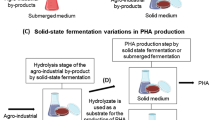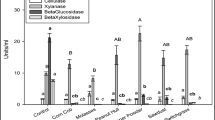Abstract
The conversion of sustainable energy crops using microbiological fermentation to biofuels and bioproducts typically uses submerged-state processes. Alternatively, solid-state fermentation processes have several advantages when compared to the typical submerged-state processes. This study compares the use of solid-state versus submerged-state fermentation using the mesophilic anaerobic bacterium Clostridium phytofermentans in the conversion of switchgrass to the end products of ethanol, acetate, and hydrogen. A shift in the ratio of metabolic products towards more acetate and hydrogen production than ethanol production was observed when C. phytofermentans was grown under solid-state conditions as compared to submerged-state conditions. Results indicated that the end product concentrations (in millimolar) obtained using solid-state fermentation were higher than using submerged-state fermentation. In contrast, the total fermentation products (in weight of product per weight of carbohydrates consumed) and switchgrass conversion were higher for submerged-state fermentation. The conversion of xylan was greater than glucan conversion under both fermentation conditions. An initial pH of 7 and moisture content of 80 % resulted in maximum end products formation. Scanning electron microscopy study showed the presence of biofilm formed by C. phytofermentans growing on switchgrass under submerged-state fermentation whereas bacterial cells attached to surface and no apparent biofilm was observed when grown under solid-state fermentation. To our knowledge, this is the first study reporting consolidated bioprocessing of a lignocellulosic substrate by a mesophilic anaerobic bacterium under solid-state fermentation conditions.





Similar content being viewed by others
References
Cantarel BL, Coutinho PM, Rancurel C, Bernard T, Lombard V, Henrissat B (2009) The carbohydrate-active enzymes database (CAZy): an expert resource for Glycogenomics. Nucleic Acids Res 37:D233–D238
Chinn MS, Nokes SE (2006) Screening of thermophilic anaerobic bacteria for solid substrate cultivation on lignocellulosic substrates. Biotechnology Progr 22:53–59
Chinn MS, Nokes SE, Strobel HJ (2007) Influence of process conditions on end product formation from Clostridium thermocellum 27405 in solid substrate cultivation on paper pulp sludge. Bioresource Technol 98:2184–2193
Chinn MS, Nokes SE, Strobel HJ (2008) Influence of moisture content and cultivation duration on Clostridium thermocellum 27405 end-product formation in solid substrate cultivation on avicel. Bioresource Technol 99:2664–2671
De Loecker R, Penninck F, Keremans R (1978) Osmotic effects of rapid dilution of cryoprotectants. I. Effect of human erythrocyte swelling. Cryo-Lett 8:131–136
Dharmagadda VSS, Nokes SE, Strobel HJ, Flythe MD (2010) Investigation of the metabolic inhibition observed in solid-substrate cultivation of Clostridium thermocellum on cellulose. Bioresource Technol 101:6039–6044
Gervais P, Molin P (2003) The role of water in solid-state fermentation. Biochem Eng J 13:85–101
Gupta S, Kapoor M, Sharma KK, Nair LM, Kuhad RC (2008) Production and recovery of an alkaline exo-polygalacturonase from Bacillus subtilis RCK under solid-state fermentation using statistical approach. Bioresource Technol 99:937–945
Herrero AA, Gomez RF, Roberts MF (1985) 31P NMR studies of Clostridium thermocellum mechanism of end product inhibition by ethanol. J Biol Chem 260:7442–7451
Hölker U, Lenz J (2005) Solid-state fermentation—are there any biotechnological advantages? Curr Opin Microbiol 8:301–306
Hoogwijk M, Faaij A, van den Broek R, Berndes G, Gielen D, Turkenburg W (2003) Exploration of the ranges of the global potential of biomass for energy. Biomass and Bioenerg 25:119–133
Jin M, Balan V, Gunawan C, Dale BE (2011) Consolidated bioprocessing (CBP) performance of Clostridium phytofermentans on AFEX-treated corn stover for ethanol production. Biotechnol Bioeng 108:1290–1297
Jin M, Gunawan C, Balan V, Dale BE (2012) Consolidated bioprocessing (CBP) AFEXTM-pretreated corn stover for ethanol production using Clostridium phytofermentans at a high solids loading. Biotechnol Bioeng. Article first published online: 22 Feb 2012. doi:10.1002/bit.24458
Kamm B, Kamm M (2004) Principles of biorefineries. Appl Microbiol Biotechnol 64:137–145
Kim JH, Hosobuchi M, Kishimoto M, Seki T, Yoshida T, Taguchi H (1985) Cellulase production by a solid state culture system. Biotechnol Bioeng 27:1445–1450
Krishna C (1999) Production of bacterial cellulases by solid state bioprocessing of banana wastes. Bioresource Technol 69:231–239
Krishna C (2005) Solid-state fermentation systems—an overview. Crit Rev Biotechnol 25:1–30
Lamed RJ, Lobos JH, Su TM (1988) Effects of stirring and hydrogen on fermentation products of Clostridium thermocellum. Appl Environ Microbiol 54:1216–1221
Leschine S (2009) Impacts of biofilm formation on cellulose fermentation. No. DOE/ER/15330-FTR
Lin Y, Tanaka S (2006) Ethanol fermentation from biomass resources: current state and prospects. Appl Microbiol Biotechnol 69:627–642
Lynd LR, Weimer PJ, van Zyl WH, Pretorius IS (2002) Microbial cellulose utilization: fundamentals and biotechnology. Microbiol Mol Biol Rev 66:506–577
McKendry P (2002) Energy production from biomass (part 1): overview of biomass. Bioresource Technol 83:37–46
McLaughlin SB, Bouton J, Bransby D, Conger B, Ocumpaugh W, Parrish D (1999) Developing switchgrass as a bioenergy crop. In: Janick J (ed) Perspectives on new crops and new uses. ASHS, Alexandra, pp 282–299
Miller GL (1959) Use of dinitrosalicylic acid reagent for determination of reducing. sugar. Anal Chem 31(3):426–428
Mukherjee AK, Adhikari H, Rai SK (2008) Production of alkaline protease by a thermophilic Bacillus subtilis under solid-state fermentation (SSF) condition using Imperata cylindrica grass and potato peel as low-cost medium: characterization and application of enzyme in detergent formulation. Biochem Eng J 39:353–361
Pandey A, Soccol CR, Mitchell D (2000) New developments in solid state fermentation: I—bioprocesses and products. Process Biochem 35:1153–1169
Pimentel D, Patzek TW (2005) Ethanol production using corn, switchgrass, and wood; biodiesel production using soybean and sunflower. Nat Resour Res 14:65–76
Robinson T, Singh D, Nigam P (2001) Solid-state fermentation: a promising microbial technology for secondary metabolite production. Appl Microbiol Biotechnol 55:284–289
Sanderson MA, Reed RL, McLaughlin SB, Wullschleger SD, Conger BV, Parrish DJ (1996) Switchgrass as a sustainable bioenergy crop. Bioresource Technol 56:83–93
Sherman SR, Goodell JJ, Milliken CE, Morris JA, Gorensek MB (2012) A new process developed for separation of lignin from ammonium hydroxide pretreatment solutions. Environ Prog Sust Energ 31:130–138
Singhania RR, Patel AK, Soccol CR, Pandey A (2009) Recent advances in solid-state fermentation. Biochem Engineering J 44:13–18
Sluiter A, Hames B, Ruiz R, Scarlata C, Sluiter J, Tepleton D, Crocker D (2011) Determination of structural carbohydrates and lignin in biomass. Technical Report, NREL/TP-510-42618. Revised July 2011
Tengerdy KH (1996) Cellulase production by solid-state fermentation. J Sci Ind Res 55:313–316
Todd WG (1972) Water deficits and enzymatic activity. In: Kozlowskim TT (ed) Plant response and control of water balance, vol. 3, water deficits and plant growth. Academic, New York, pp 117–216
Tolonen AC, Haas W, Chilaka AC, Aach J, Gygi SP, Church GM (2011) Proteome-wide systems analysis of a cellulosic biofuel-producing microbe. Mol Syst Biol 7:461
Warnick TA, Methe BA, Leschine SB (2002) Clostridium phytofermentans sp. nov., a cellulolytic mesophile from forest soil. Int J Syst Evol Micr 52:1155–1160
Weber C, Farwick A, Benisch F, Brat D, Dietz H, Subtil T (2010) Trends and challenges in the microbial production of lignocellulosic bioalcohol fuels. Appl Microbiol Biotechnol 87:1303–1315
Wolfe J, Steponkus PL (1983) Tension in the plasma membrane during osmotic contraction. Cryo-Lett 4:315–322
Zhuang J (2004) Economic analysis of cellulase production by Clostridium thermocellum in solid state and submerged fermentation. Thesis, University of Kentucky
Acknowledgments
This research was funded by US Department of Energy award number DE-FG36-08GO88071. The authors acknowledge the assistance of Jim Frederick at the Pee Dee Research Center where the switchgrass was grown and harvested, JoAn Hudson for assistance with electron microscopy, and the guidance of Karl Kelly.
Author information
Authors and Affiliations
Corresponding author
Rights and permissions
About this article
Cite this article
Jain, A., Morlok, C.K. & Henson, J.M. Comparison of solid-state and submerged-state fermentation for the bioprocessing of switchgrass to ethanol and acetate by Clostridium phytofermentans . Appl Microbiol Biotechnol 97, 905–917 (2013). https://doi.org/10.1007/s00253-012-4511-4
Received:
Revised:
Accepted:
Published:
Issue Date:
DOI: https://doi.org/10.1007/s00253-012-4511-4




